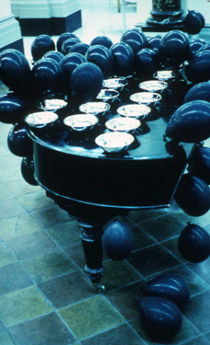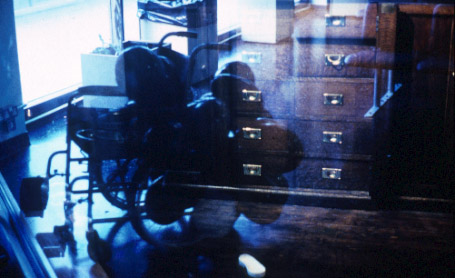DISORDERS
H
For
"Disorders"
at St. Thomas' Hospital, Westminster Bridge Road, London, UK.
24 hour non-stop actuation
Dawn 15th - Dawn 16th August 1996
* * *

From
"Low Tide - Writings On Artists' Collaborations"
Jeni
Walwin
[...]
Alastair
MacLennan is best known for his durational performances and this event
gave him the ability to demonstrate his commitment to this practice in
an especially appropriate work. His was perhaps one of the most ambitious
and physically demanding presentations. He maintained a waking presence
in one of two sites in the hospital for the entire twenty-four hours.
Changing locations on the hour every hour he performed alternately in
the Central Hall of the South Wing and in the Old Pharmacy of the Lambeth
Wing. In the Central Hall, a large tiled Victorian space housing a small
collection of stone statues and a grand piano, MacLennan introduced a
number of items. He arranged around the space many helium filled balloons
(mostly black and a smaller number of white), two Zimmer frames, black
and white photographic negatives, twenty-five silver bowls, some remaining
empty, and some containing water, leaves, marbles, a small metal rowing
boat and a dismantled child's shoe. MacLennan moved slowly, almost imperceptibly,
around this space, sometimes gently pushing a wheel chair decorated with
white balloons. The only other action was the slow and barely visible
deflation of the balloons. The atmosphere generated was intense yet calm,
unnerving yet contemplative. Whilst the visual evidence confronting us
was loaded with expectation and heavy with symbolism, the sombre character
of the artefacts was transformed by the grace and serenity of the action
itself. Out of the sinister and disturbing environment there came a possibility
of spiritual renewal.

 Only
the wheelchair, a section of the child's shoe, and a smaller selection
of balloons were installed in MacLennan's second space which was already
filled with artefacts from its own history. The Old Pharmacy represents
a small piece of hospital archaeology on display in the corner of a large
waiting room. In front of the glazed screen, spectators were able to witness
MacLennan's precise, meditative actions in this tiny space. Flasks, scales,
phials, measuring jugs, storage jars and bottles were continually repositioned.
On a formal level the space was constantly sculpted into new dimensions
as each shelf or table was dismantled and reassembled elsewhere. But in
the process of this action which was both careful and deliberate we contemplated
the history and use of each item as its new display spot was allocated.
Medicine has progressed far and fast in technological terms since the
containers in this pharmacy were in daily use and yet the MacLennan additions
to the space (the wheelchair, etc.) reminded us that the afflictions are
just the same.
Only
the wheelchair, a section of the child's shoe, and a smaller selection
of balloons were installed in MacLennan's second space which was already
filled with artefacts from its own history. The Old Pharmacy represents
a small piece of hospital archaeology on display in the corner of a large
waiting room. In front of the glazed screen, spectators were able to witness
MacLennan's precise, meditative actions in this tiny space. Flasks, scales,
phials, measuring jugs, storage jars and bottles were continually repositioned.
On a formal level the space was constantly sculpted into new dimensions
as each shelf or table was dismantled and reassembled elsewhere. But in
the process of this action which was both careful and deliberate we contemplated
the history and use of each item as its new display spot was allocated.
Medicine has progressed far and fast in technological terms since the
containers in this pharmacy were in daily use and yet the MacLennan additions
to the space (the wheelchair, etc.) reminded us that the afflictions are
just the same.
[...]
